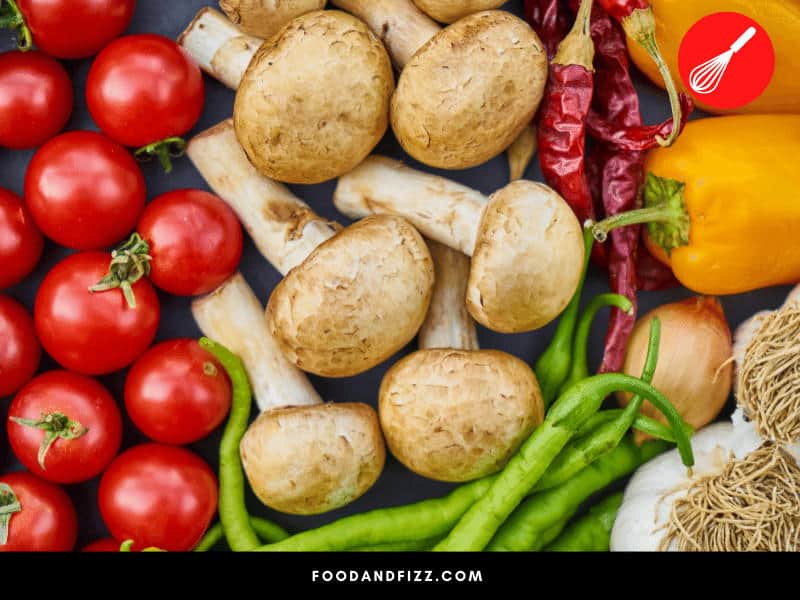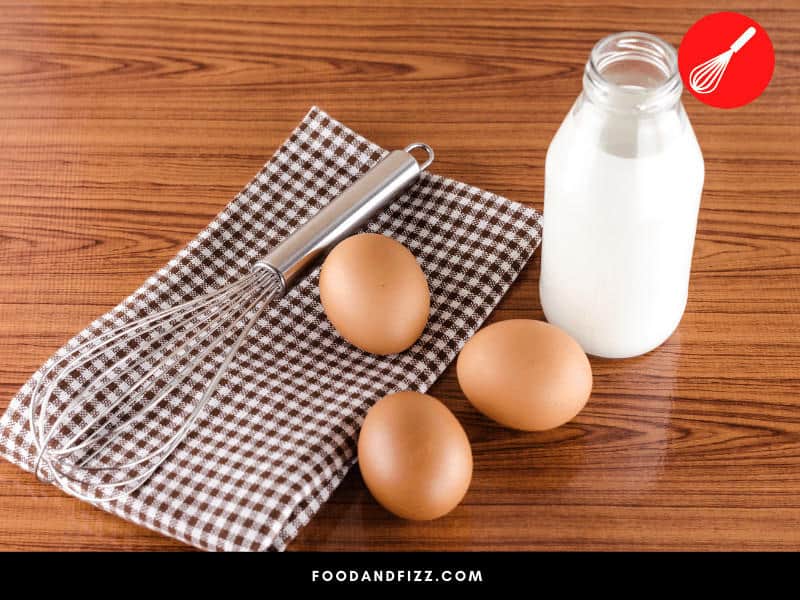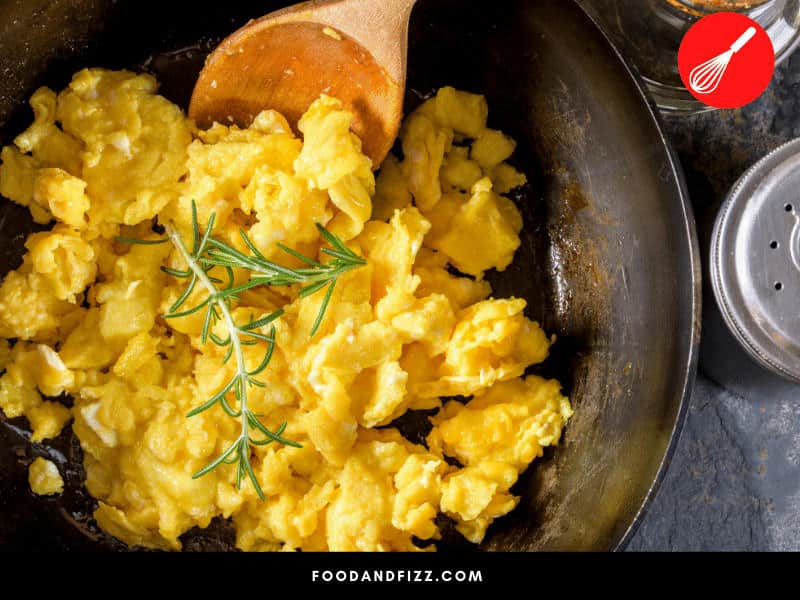I always used to think that I couldn’t mess up boiled eggs. Turns out I was wrong.
Turns out, what I needed to do was come home slightly inebriated–well, okay, very inebriated–dunk some eggs into boiling water, then fall asleep on the couch. That there’s a solid gold recipe for waking up to a smoking ruin of inedible charred-black, hard, boiled eggs.
Other egg dishes are easier to wreck without taking such extreme measures. Omelets that are tough and chewy, egg curries where you can’t find the egg, fried eggs that haven’t fried (or have fried to where you’d rather not eat them, thanks anyway), and scrambled eggs that drowned and died an ignominious death.
Why are my scrambled eggs watery?
Watery scrambled eggs result from one or more of these four mistakes: cooking scrambled eggs with vegetables that release water, adding too much milk to the eggs, cooking scrambled eggs on heat that is too high, or using too many eggs at once.

How to Detect Watery Scrambled Eggs
The usual way to detect watery scrambled eggs is to dish them out. This is when most people discover, to their horror, that they’ve messed up.
Water seeps out from the eggs and arranges itself into probably one of the most amazingly disgusting things you’ll ever have the misfortune of seeing on your breakfast plate.
The issue with preparing scrambled eggs is that it is a delicate balancing act. It takes time to learn and acquire the skills to apply successful cooking techniques to make perfect scrambled eggs.
Part of learning how to avoid making watery scrambled eggs is learning why scrambled eggs turn out watery and what you can do to prevent it.
After that, it’s a matter of “get into the kitchen, roll up your sleeves, get jiggy with it,” as a sous-chef I used to work under repeated like a mantra, ad nauseam.
Reasons Why Scrambled Eggs Turn Out Watery
Here are four mistakes inexperienced scrambled eggs cooks make almost as a rite of passage. Once understood, you can take action to avoid repeating them and virtually guarantee perfectly cooked scrambled eggs every time.
1. Adding the wrong kinds of vegetables to the eggs
When heated in a pan, many veggies “let go” of their water content. Zucchini, mushrooms, and tomatoes are perfect examples of such veggies; chillies and beans, not so much. So, the thing to do with the “cry baby” vegetables is to not chuck them into your scrambled eggs mix but sauté them first.
Put some butter in a pan and melt the butter over moderate heat. When the butter has melted, add the vegetables and some seasoning. If you don’t, the meal will come out perfectly cooked but just as perfectly tasteless, which I’m sure would be a disappointment.
Keep stirring the pan’s contents and watch closely to see when the veggies start “weeping.” “Weeping” is the actual term used in kitchens all over the world.
Quickly drain the moisture from the pan. Do your utmost to avoid letting the pan and its contents cool, so I’m talking about rapid action here.
Return the pan to the stove and continue stirring to see if the veggies let go yet more juice. Whether they do or not, drain the vegetables when they are done and set them aside. When the eggs in the pan begin to solidify, add your sauteéd veggies . This will give you perfectly cooked, well-seasoned vegetables in your scrambled eggs.

2. Adding too much milk to the egg mix
Adding milk to the eggs before you whisk them more or less guarantees soft, fluffy, scrambled eggs. The trouble is, many folks add a little too much milk to the eggs, ensuring a hot mess of watery scrambled eggs. Knowing how much milk to add to your eggs is key to avoiding this trap.
As a rule of thumb, add a tablespoon (or, at most, two tablespoons) of milk to every egg in your egg mix. For two eggs, use two to four tablespoons of milk. For four eggs, use four to eight tablespoons of milk, and so on.
The reason for using the higher end of the scale is to produce ‘lighter’ scrambled eggs. These will be whiter and taste less like eggs and more like whatever seasoning and vegetables you’ve used. Scrambled eggs done this way aren’t to everyone’s taste.

3. Cooking scrambled eggs at a temperature that is too high
High heat extracts moisture from the eggs in the pan, but the liquid remains trapped by the heat until you’ve served the eggs (which is why watery eggs typically become apparent only after putting them on a plate).
To make soft, fluffy, scrambled eggs, cook them over low heat. For firmer scrambled eggs, cook over medium heat. In all instances, do not stir the eggs madly, but gently tease them with a rubbery spatula. (A metal spatula will prevent you from getting to the edges, and you’ll end up with those horrid, dry, curled bits that everyone hates.)
People tend to cook with the heat turned up because they are in a hurry and want to get their eggs made quickly. No! Scrambled eggs are one of those dishes that take as long as they take; you can’t hurry them if you want a decent meal.
If you want eggs in a hurry, I recommend fried eggs or an omelet. Anyway, there’s a fantastic range of egg dishes you can choose from.

4. Trying to make a lot of scrambled eggs in one go
Too many eggs in the pan make it hard to stir long enough for scrambling but quickly enough to get the heat evenly distributed over all the eggs. Inevitably, you will give some parts of the eggs in the pan sufficient time to start “weeping” while you try to get other parts to cook at all.
In the end, you end up with either a soggy, unappetizing mess of watery, over and undercooked eggs(!)
Quick Tips for Making Perfect Scrambled Eggs
- Don’t whisk the eggs in the pan! Whisk them in a bowl first for first-class scrambled eggs.
- Don’t leave the pan “for a moment.” With scrambled eggs, you’re either stirring or pouring. Anything else, you’re messing up.
- Don’t leave it too late to turn off the heat under the pan. Scrambled eggs keep cooking until you decant them, so turn off the heat while the eggs are still slightly underdone.
- Don’t crack eggs against the side of the bowl. Everyone absolutely hates the crunch of eggshells.

Afterword: Why are my scrambled eggs watery?
Watery scrambled eggs are a horribly disappointing late-stage discovery–you tend to find out that you’ve messed up after you’ve decanted what you thought were perfect scrambled eggs onto your plate. Suddenly, your eggs are going one way, and oily water another.
Avoiding this unattractive experience is a matter of learning a few simple techniques and knowing the “gotchas” that otherwise wreck many a breakfast table all across America.
Frequently Asked Questions on Why Are My Scrambled Eggs Watery?
How can I recover from making watery scrambled eggs?
Surprisingly, there’s a simple recovery strategy that works pretty well. Drain the eggs in a colander and let them stand for a minute or two. Put a pan with some oil over high heat (don’t use butter because of butter’s low smoke point). When the oil is hot, flash fry the scrambled eggs and ensure they never get to sit in one place long enough to burn. Return to a plate as soon as the eggs are nicely piping hot again.

